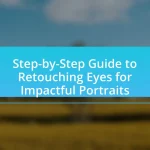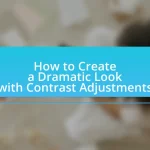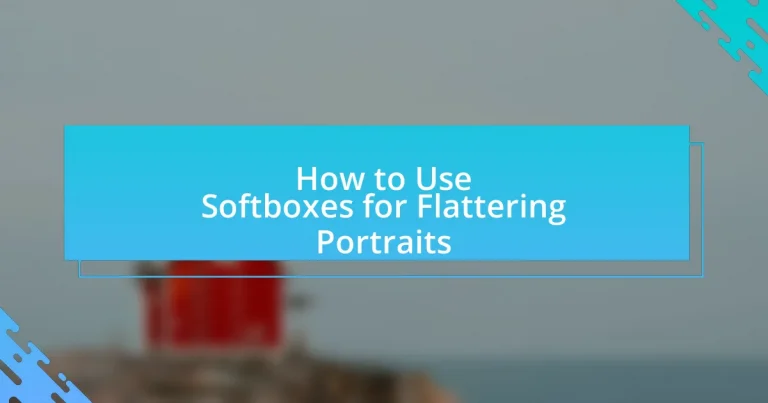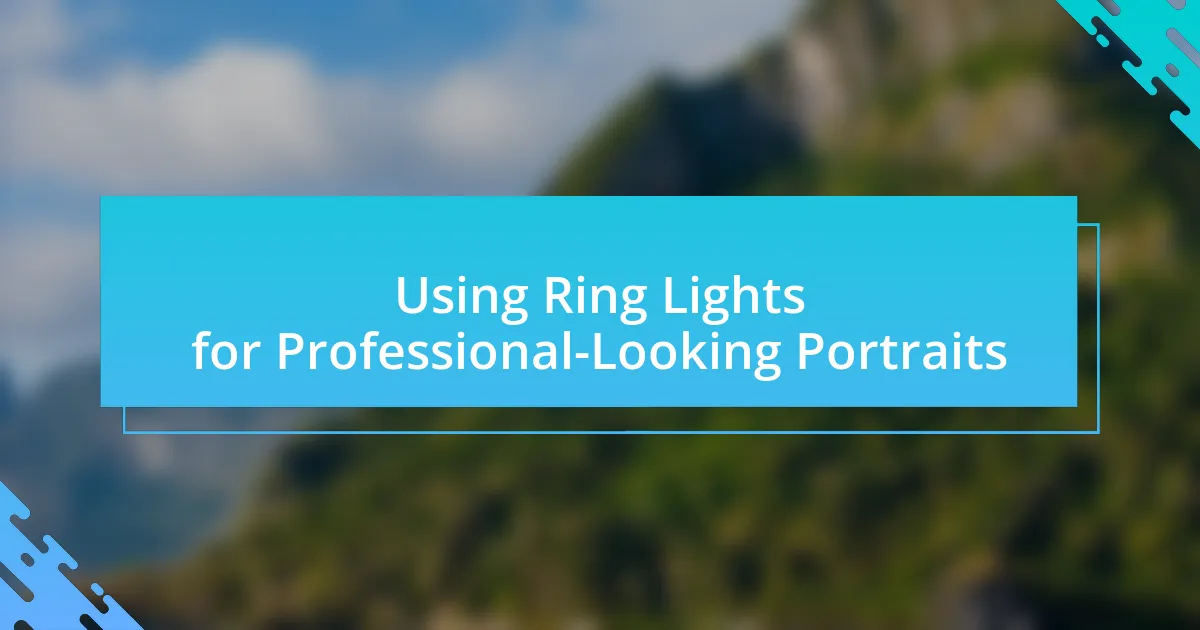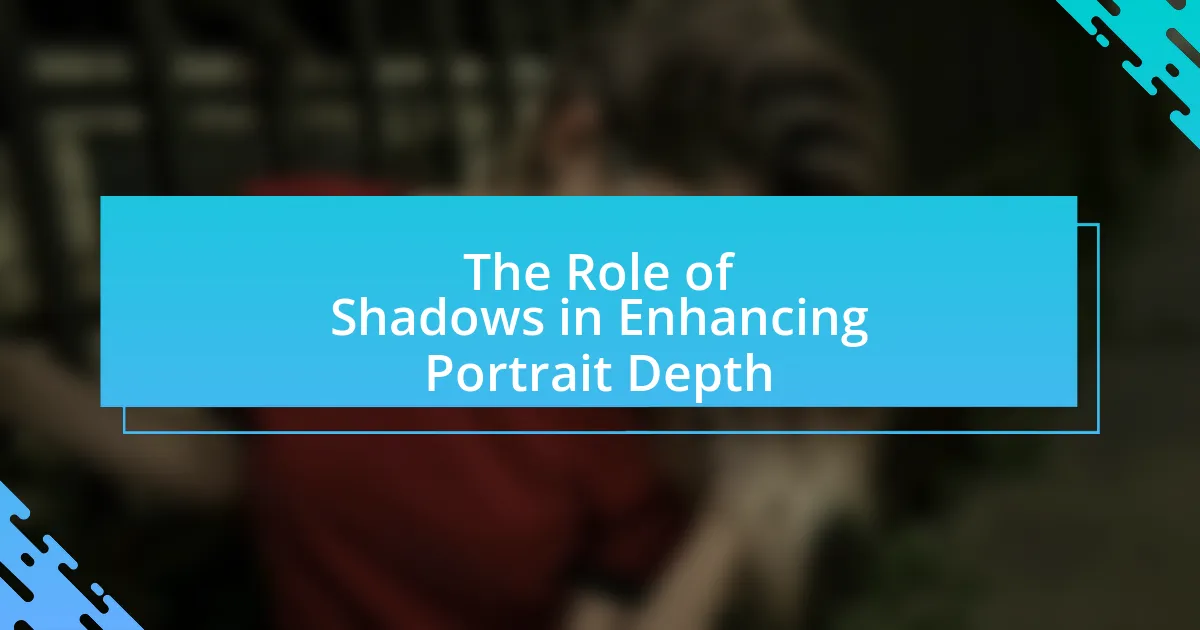Softboxes are essential lighting modifiers in portrait photography, designed to diffuse light and create soft, even illumination that flatters subjects. This article explores the functionality of softboxes, detailing their key components, advantages, and how they differ from other lighting sources. It also covers the optimal sizes and types of softboxes for various portrait styles, as well as best practices for setup and positioning to achieve natural-looking results. Additionally, the article addresses common mistakes to avoid and offers troubleshooting tips to enhance softbox performance, ensuring photographers can effectively utilize this equipment for high-quality portraits.

What are Softboxes and How Do They Work for Portrait Photography?
Softboxes are lighting modifiers used in photography to diffuse light, creating a soft and even illumination that is ideal for portrait photography. They work by enclosing a light source, such as a flash or continuous light, within a fabric box that has a reflective interior and a translucent front panel. This design allows the light to spread out and soften, reducing harsh shadows and highlights on the subject’s face, which is crucial for flattering portraits. The effectiveness of softboxes is supported by their ability to mimic natural light, providing a more pleasing aesthetic that enhances skin tones and textures.
How do softboxes differ from other lighting sources?
Softboxes differ from other lighting sources primarily in their ability to diffuse light, creating a softer and more even illumination. Unlike bare bulbs or hard light sources, which produce harsh shadows and highlights, softboxes utilize a fabric diffusion material that spreads the light over a larger area, resulting in a more flattering effect on subjects. This characteristic is particularly beneficial in portrait photography, as it minimizes skin imperfections and enhances the overall aesthetic. The design of softboxes also allows for greater control over the direction and quality of light, making them a preferred choice for professional photographers aiming for high-quality results.
What are the key components of a softbox?
The key components of a softbox include the outer shell, the diffusion material, the internal reflective surface, and the mounting system. The outer shell is typically made of fabric or other lightweight materials that shape the light. The diffusion material softens the light, reducing harsh shadows. The internal reflective surface enhances light distribution by reflecting it towards the diffusion layer. The mounting system allows the softbox to be attached to light sources securely, ensuring stability during use. These components work together to create a soft, even light that is ideal for flattering portraits.
How does the diffusion material affect light quality?
Diffusion material significantly affects light quality by softening and scattering the light, which reduces harsh shadows and creates a more even illumination. This softening effect enhances the overall appearance of subjects in portrait photography, making skin tones appear more natural and reducing the contrast that can lead to unflattering images. Studies in photography demonstrate that using diffusion materials, such as fabric or plastic, can increase the light’s effective spread, resulting in a more pleasing aesthetic for portraits.
What advantages do softboxes offer for flattering portraits?
Softboxes provide soft, diffused lighting that minimizes harsh shadows and highlights, making them ideal for flattering portraits. This type of lighting enhances skin tones and textures, creating a more appealing and natural look. Additionally, softboxes allow for greater control over light direction and intensity, enabling photographers to shape the light to complement the subject’s features effectively. The diffusion material used in softboxes spreads the light evenly, reducing the risk of overexposure and ensuring a balanced illumination across the portrait.
How do softboxes create soft, even lighting?
Softboxes create soft, even lighting by diffusing the light emitted from a bulb through a translucent material. This diffusion process reduces harsh shadows and spreads the light more uniformly across the subject, resulting in a gentle illumination that enhances skin tones and textures. The larger the softbox, the softer and more even the light becomes, as it mimics the effect of natural light sources, such as the sun on an overcast day.
Why is soft lighting important for portrait photography?
Soft lighting is important for portrait photography because it minimizes harsh shadows and creates a flattering, even illumination on the subject’s face. This type of lighting enhances skin tones and textures, making the subject appear more natural and appealing. Studies in photography have shown that soft lighting can significantly improve the aesthetic quality of portraits by reducing contrast and highlighting the subject’s features in a gentle manner.
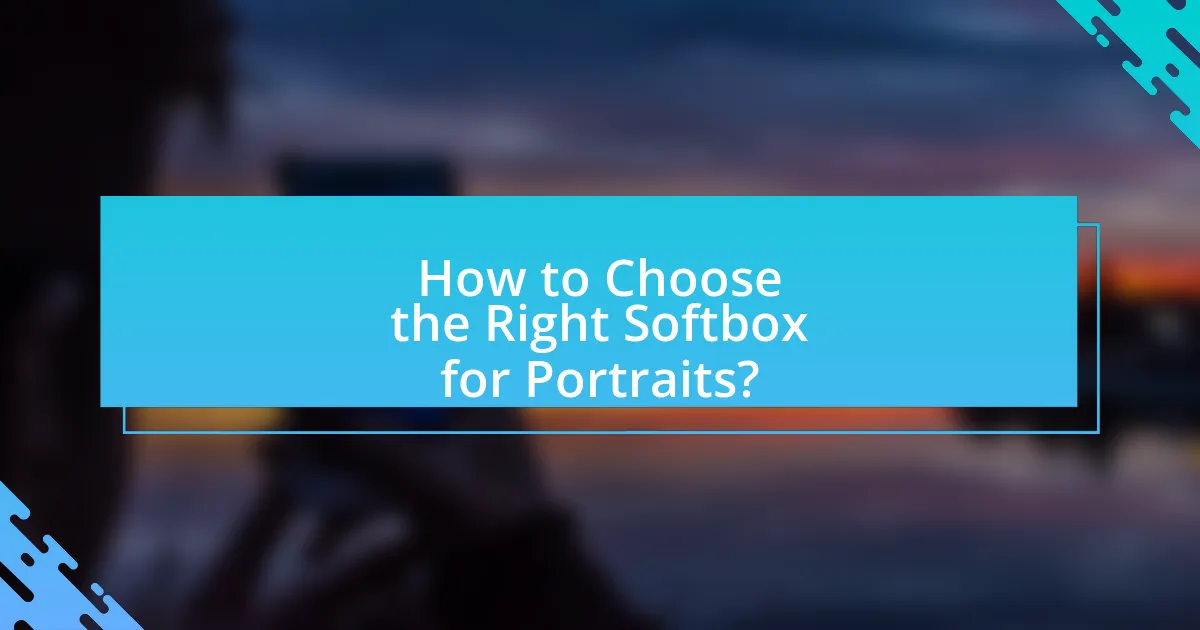
How to Choose the Right Softbox for Portraits?
To choose the right softbox for portraits, select a softbox that provides a large surface area to create soft, diffused light. A larger softbox, such as a 36-inch or 48-inch option, will produce softer shadows and more flattering results on skin tones, which is essential for portrait photography. Additionally, consider the shape of the softbox; rectangular softboxes can create a more natural light pattern, while octagonal softboxes provide a round catchlight in the eyes, enhancing the portrait’s appeal. The material and diffusion quality also matter; high-quality fabrics will ensure even light distribution and durability.
What sizes of softboxes are best for portrait photography?
The best sizes of softboxes for portrait photography are typically 24×36 inches and 36×48 inches. These dimensions provide a balance between soft light and manageable size, allowing for flattering illumination on the subject’s face while minimizing harsh shadows. A 24×36 inch softbox is ideal for head-and-shoulders portraits, while a 36×48 inch softbox is better suited for full-body shots, as it covers a larger area and creates a more even light distribution. This is supported by the fact that larger softboxes produce softer light due to the increased surface area, which diffuses the light more effectively, enhancing the overall quality of the portrait.
How does the size of a softbox influence the lighting effect?
The size of a softbox significantly influences the lighting effect by determining the softness and spread of the light. Larger softboxes produce softer light with a broader spread, which reduces harsh shadows and creates a more flattering appearance on subjects. In contrast, smaller softboxes generate harder light with a more concentrated beam, resulting in sharper shadows and more defined features. This effect is due to the inverse square law of light, which states that light intensity decreases with distance; thus, larger softboxes allow light to diffuse over a wider area, enhancing the overall quality of the illumination.
What are the recommended sizes for different portrait styles?
The recommended sizes for different portrait styles typically range from 8×10 inches for standard portraits to 16×20 inches for larger, more detailed images. Standard headshots often use sizes like 5×7 inches or 8×10 inches, while full-body portraits may be best represented in sizes such as 11×14 inches or larger. These dimensions are commonly used in professional photography to ensure clarity and detail, allowing for effective display and framing.
What types of softboxes are available for photographers?
Photographers have access to several types of softboxes, including rectangular, square, octagonal, and strip softboxes. Rectangular softboxes are versatile and commonly used for portraits, providing a broad light source. Square softboxes offer a more even light distribution, ideal for headshots. Octagonal softboxes create a natural catchlight in the eyes, mimicking the shape of the sun. Strip softboxes are long and narrow, perfect for creating rim lighting or accentuating specific areas of a subject. Each type serves distinct purposes in achieving flattering portraits by controlling light quality and direction.
What are the differences between rectangular and octagonal softboxes?
Rectangular softboxes produce a more directional light with defined shadows, making them ideal for creating contrast and depth in portraits. In contrast, octagonal softboxes emit a softer, more diffused light that wraps around the subject, resulting in a more flattering and even illumination. The shape of the softbox affects the quality of light; rectangular softboxes are often used for fashion and product photography, while octagonal softboxes are preferred for portrait photography due to their ability to mimic natural light sources.
How do collapsible softboxes enhance portability?
Collapsible softboxes enhance portability by allowing photographers to easily fold and store them in compact sizes. This design feature significantly reduces the space required for transport, making it convenient for on-location shoots. For instance, many collapsible softboxes can be compressed to a fraction of their open size, often fitting into standard camera bags or backpacks. This portability is crucial for photographers who frequently travel or work in various environments, as it enables them to carry essential lighting equipment without the burden of bulky gear.
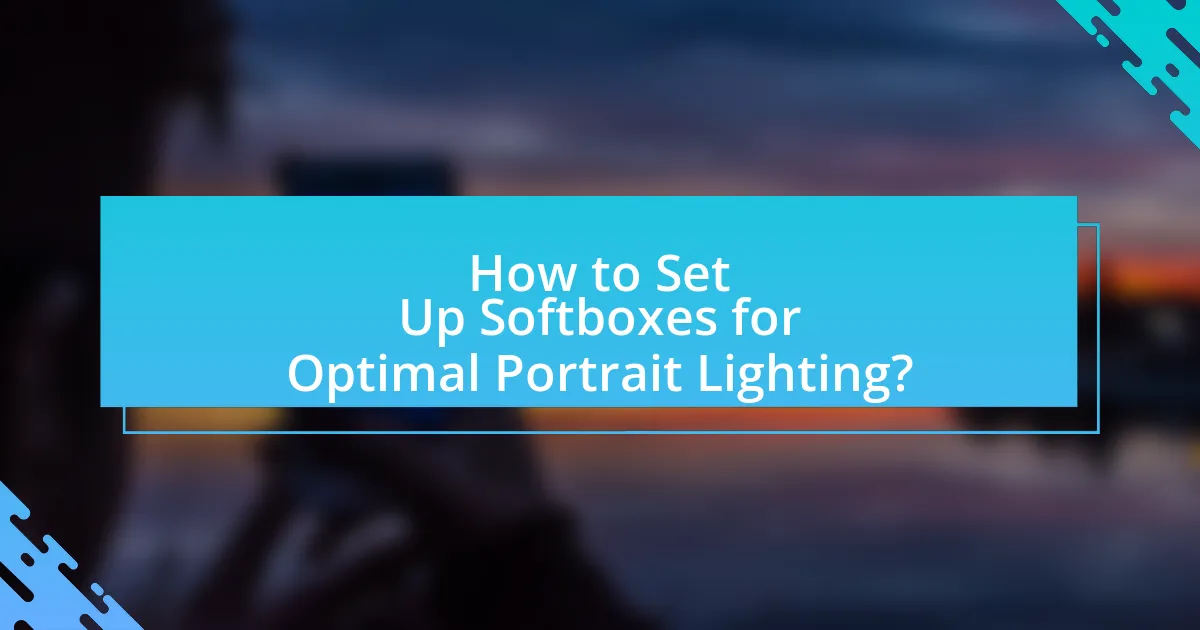
How to Set Up Softboxes for Optimal Portrait Lighting?
To set up softboxes for optimal portrait lighting, position the softbox at a 45-degree angle to the subject and slightly above eye level. This angle creates flattering shadows and highlights, enhancing facial features. The distance between the softbox and the subject should be adjusted to achieve the desired softness of light; closer placement results in softer light, while moving it further away creates a harsher effect. Using a larger softbox also contributes to softer light quality, as it diffuses light over a broader area. Properly diffusing the light through the softbox fabric minimizes harsh shadows, making the portrait more appealing.
What are the best positions for softboxes in portrait photography?
The best positions for softboxes in portrait photography are typically at a 45-degree angle to the subject and slightly above eye level. This positioning creates flattering light that enhances facial features while minimizing harsh shadows. Placing the softbox at this angle allows for soft, even illumination across the subject’s face, which is essential for achieving a professional look in portraits. Additionally, using a second softbox as a fill light can help reduce shadows on the opposite side of the face, further enhancing the overall quality of the portrait.
How does the angle of the softbox affect shadows and highlights?
The angle of the softbox significantly influences the characteristics of shadows and highlights in photography. When the softbox is positioned at a higher angle, it creates softer shadows and more even highlights, as the light spreads more uniformly across the subject. Conversely, a lower angle can produce harsher shadows and more pronounced highlights, emphasizing texture and detail. This effect occurs because the direction of the light source alters how it interacts with the subject’s features, affecting the depth and intensity of shadows.
What is the ideal distance between the softbox and the subject?
The ideal distance between the softbox and the subject is typically between 2 to 6 feet. This range allows for optimal diffusion of light, creating a soft and flattering effect on the subject’s features. At 2 feet, the light is more intense and can create sharper shadows, while at 6 feet, the light becomes softer and more diffused, reducing harsh shadows. This information is supported by photography guidelines that emphasize the importance of distance in achieving desired lighting effects in portrait photography.
How can you modify softbox lighting for different effects?
You can modify softbox lighting for different effects by adjusting the distance, angle, and diffusion material used. Changing the distance between the softbox and the subject alters the intensity and softness of the light; closer positioning creates a softer light with more flattering shadows, while moving it further away results in a harsher light. Adjusting the angle of the softbox can create different shadow patterns, enhancing facial features or adding depth to the image. Additionally, using different diffusion materials, such as a thicker fabric or a grid, can control the spread of light and reduce spill, allowing for more focused lighting effects. These modifications are essential for achieving various artistic outcomes in portrait photography.
What accessories can enhance softbox performance?
Accessories that can enhance softbox performance include diffusion materials, reflectors, and grids. Diffusion materials, such as silk or nylon, soften the light output, reducing harsh shadows and creating a more flattering effect on subjects. Reflectors can redirect light, increasing the overall illumination and filling in shadows, which is particularly useful in portrait photography. Grids help control the spread of light, allowing for more focused illumination and reducing spill, which is essential for achieving a polished look in portraits. These accessories collectively improve the quality and control of light produced by softboxes, making them more effective for flattering portrait photography.
How do gels and grids change the lighting characteristics?
Gels and grids significantly alter lighting characteristics by modifying color and controlling light spread. Gels are colored filters placed in front of lights to change the color temperature or hue, allowing for creative effects or correction of lighting mismatches. For instance, a blue gel can cool down warm light, while a red gel can warm up cool light, enhancing the overall mood of a portrait. Grids, on the other hand, narrow the beam of light, creating more focused illumination and reducing spill, which helps in achieving dramatic shadows and highlights. This focused light can enhance facial features and add depth to portraits, making them more visually appealing. The combination of gels and grids allows photographers to fine-tune their lighting setups, resulting in more controlled and artistic outcomes in portrait photography.
What are some common mistakes to avoid when using softboxes?
Common mistakes to avoid when using softboxes include improper positioning, incorrect light intensity, and neglecting to control ambient light. Positioning the softbox too close to the subject can create harsh shadows, while placing it too far can result in insufficient illumination. Using the wrong light intensity can lead to overexposed or underexposed images, diminishing the quality of the portrait. Additionally, failing to manage ambient light can cause unwanted color casts and inconsistencies in lighting, which detracts from the overall effect. These mistakes can significantly impact the final outcome of portrait photography, making awareness and correction essential for achieving flattering results.
How can improper positioning affect portrait quality?
Improper positioning can significantly degrade portrait quality by causing unflattering shadows, awkward angles, and distortion of facial features. When a subject is not positioned correctly relative to the light source, such as a softbox, harsh shadows may appear on the face, detracting from the overall aesthetic. Additionally, angles that are too high or low can distort proportions, making features appear larger or smaller than they are. Studies in photography emphasize that optimal positioning enhances the natural beauty of the subject, ensuring that light falls evenly and highlights the desired attributes.
What are the pitfalls of using too many light sources?
Using too many light sources can lead to overexposure, creating harsh shadows and an unflattering appearance in portraits. When multiple light sources are employed, they can cause conflicting shadows and highlights, which detracts from the subject’s features. Additionally, excessive lighting can result in a cluttered visual aesthetic, making it difficult for the viewer to focus on the subject. Studies in photography emphasize that a balanced lighting setup enhances the subject’s natural beauty, while too many sources can overwhelm the composition and distort the intended mood.
What are the best practices for using softboxes in portrait photography?
The best practices for using softboxes in portrait photography include positioning the softbox at a 45-degree angle to the subject, ensuring the light is diffused evenly, and adjusting the distance to control the softness of the light. Positioning the softbox at a 45-degree angle helps create natural shadows that enhance facial features, while even diffusion reduces harsh lighting and minimizes blemishes. Adjusting the distance allows photographers to manipulate the light’s intensity; closer softboxes produce softer light, while those further away yield a more dramatic effect. These practices are supported by the principles of light behavior in photography, which emphasize the importance of light direction and quality in achieving flattering portraits.
How can you achieve a natural look with softboxes?
To achieve a natural look with softboxes, position the softbox at a 45-degree angle to the subject and slightly above eye level. This placement mimics natural sunlight, creating soft shadows and highlights that enhance facial features without harsh contrasts. Additionally, using a larger softbox increases the surface area of the light source, resulting in a more diffused light that closely resembles natural lighting conditions. This technique is supported by the principle that larger light sources produce softer shadows, which is essential for flattering portraits.
What tips can help in troubleshooting softbox lighting issues?
To troubleshoot softbox lighting issues, first check the power source and ensure that the bulbs are functioning properly. If the light is dim or not working, replace any burnt-out bulbs and verify that the softbox is plugged in securely. Additionally, adjust the distance of the softbox from the subject to achieve the desired light intensity; closer placement increases brightness while further placement softens the light. Lastly, inspect the softbox for any damage or obstructions that may affect light diffusion, as a torn fabric or debris can lead to uneven lighting. These steps are essential for achieving optimal lighting conditions in portrait photography.




